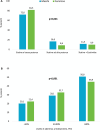Differenze di genere e ipercolesterolemia: evidenze real-world dallo studio WECARE (Women Effective CArdiovascular Risk Evaluation)
- PMID: 38872910
- PMCID: PMC11171707
- DOI: 10.33393/grhta.2024.2731
Differenze di genere e ipercolesterolemia: evidenze real-world dallo studio WECARE (Women Effective CArdiovascular Risk Evaluation)
Abstract
Introduction:: The therapeutic control of LDL-cholesterol is essential in cardiovascular prevention, as recommended by the recent guidelines.
Objective:: To evaluate gender differences in terms of demographic and clinical characteristics, treatment pattern, treatment adherence and healthcare costs in patients on lipid-lowering therapy, stratified by cardiovascular risk in the Italian real clinical practice.
Methods:: An observational analysis was conducted on the administrative databases of healthcare institutions, covering about 6.1 million health-assisted subjects. After inclusion of all patients on lipid-lowering therapy between January 2017 and June 2020, the population was investigated in the period before the first prescription of a lipid-lowering drug and followed-up for at least 12 months. Clinical and demographic variables were compared after stratification by gender and by cardiovascular risk (very high/high/other risk). The main outcome measures were treatment adherence and direct healthcare costs during follow-up.
Results:: Of the 684,829 patients with high/very high cardiovascular risk, 337,394 were men and 347,435 women, aged on average 69.3 years and 72.1 years, respectively (p < 0.001). Men were characterised by a worse comorbidity profile. Regardless of cardiovascular risk, female subjects were associated with larger utilisation of low-potency statins and lower adherence (p < 0.001). The annual healthcare costs per patient during follow-up were higher in men than in women (p < 0.001).
Conclusions:: The results highlighted larger utilisation of low-potency statins, a lower adherence and a milder comorbidity profile in women, the latter feasibly explaining the reduced healthcare costs compared to men.
Figures




References
-
- Ference BA, Ginsberg HN, Graham I et al. Low-density lipoproteins cause atherosclerotic cardiovascular disease. 1. Evidence from genetic, epidemiologic, and clinical studies. A consensus statement from the European Atherosclerosis Society Consensus Panel. Eur Heart J. 2017;38(32):2459–2472. doi: 10.1093/eurheartj/ehx144. - DOI - PMC - PubMed
-
- Jeong HS, Hong SJ, Cho JM et al. A Multicenter, Randomized, Double-blind, Active-controlled, Factorial Design, Phase III Clinical Trial to Evaluate the Efficacy and Safety of Combination Therapy of Pitavastatin and Ezetimibe Versus Monotherapy of Pitavastatin in Patients With Primary Hypercholesterolemia. Clin Ther. 2022;44(10):1310–1325. doi: 10.1016/j.clinthera.2022.09.001. - DOI - PubMed
-
- Lipinski MJ, Benedetto U, Escarcega RO et al. The impact of proprotein convertase subtilisin-kexin type 9 serine protease inhibitors on lipid levels and outcomes in patients with primary hypercholesterolaemia: a network meta-analysis. Eur Heart J. 2016;37(6):536–545. doi: 10.1093/eurheartj/ehv563. - DOI - PubMed
LinkOut - more resources
Full Text Sources

